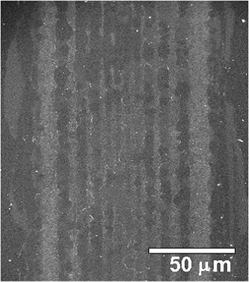No CrossRef data available.
Article contents
Photoinduced formation of thin-film structures in titanium alkoxides via direct deposition from solution and from spin-coated solid-state precursor films
Published online by Cambridge University Press: 11 March 2011
Abstract

The photoinduced formation of thin film structures from a Ti-alkoxide precursor (OPy)2Ti(TAP)2, where OPy = OC6H6N, TAP = OC6H2[CH2N(CH3)2]3-2,4,6, was demonstrated via direct deposition from a pyridine-based solution and by optical illumination of a solid-state spin-coated thin film of the compound. Photopatterned physical relief structures were produced using both of these deposition methods and feature sizes as small as ∼1 μm were readily achieved. Surface investigations of the material’s nanostructure revealed that films photo-deposited from solution exhibited nanometer-scale surface roughness with evenly distributed surface porosity (∼10 nm sized pores) while films produced through the illumination of spin-coated thin films exhibited, in comparison, a reduction in surface roughness. Vibrational spectra were compared with the results of quantum chemical computations (density-functional theory) of potential photoproducts in an attempt to identify and distinguish the dominant structural groups resulting from the optical processing of each precursor form (i.e., solution versus solid-state). It was determined that ultraviolet irradiation for both thin-film formation techniques resulted in a disruption of the ligand groups, facilitating the initiation of hydrolysis and condensation reactions in the films.
Keywords
- Type
- Articles
- Information
- Copyright
- Copyright © Materials Research Society 2011


